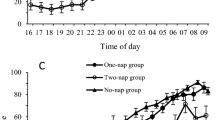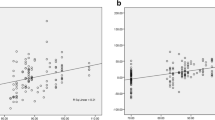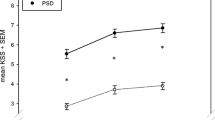Abstract
Objective
Nocturnal aircraft noise disturbs sleep and impairs recuperation. We investigated in laboratory and field studies whether noise-induced sleep fragmentation is associated with performance impairments in a psychomotor vigilance task (PVT) and a memory search task.
Methods
In the laboratory, 112 participants were exposed to aircraft noise during 9 consecutive nights. In the field, 64 participants were examined during 9 consecutive nights in the vicinity of Cologne/Bonn airport. Reaction time, signal detection performance and subjective task load were recorded.
Results
Dose–response relationships showed significant, linear impairments in reaction times. In the laboratory, reaction time in PVT increased with 0.13 ms/dB equivalent noise level (LAeq) plus 0.02 ms/noise event. In the field study, reaction time increased with 0.3 ms/dB LAeq. Participants worked significantly less accurate after nocturnal noise exposure.
Conclusion
Influences of LAeq and number of noise events on daytime performance were small but consistent and significant, stressing the potential public health impact of nocturnal noise exposure.



Similar content being viewed by others
References
AGARD. AGARDOGRAPH No. 308 (1989) Human performance assessment methods. AMP Working Group 12 and AGARD Lecture Series 163. AGARD-AG-308. Neuilly-Sur-Seine, AGARD
Basner M (2008) Nocturnal aircraft noise exposure increases objectively assessed daytime sleepiness. Somnologie 12:110–117
Basner M, Samel A (2004) Nocturnal aircraft noise effects. Noise Health 6:83–93
Basner M, Samel A (2005) Effects of nocturnal aircraft noise on sleep structure. Somnologie 9:84–95
Basner M, Buess H, Elmenhorst D, Gerlich A, Luks N, Maaß H, Mawet L, Müller EW, Müller U, Plath G, Quehl J, Samel A, Schulze M, Vejvoda M, Wenzel J (2004) Effects of nocturnal aircraft noise. vol 1, Executive summary. FB2004-07/E, ISSN 1434-8454. Cologne, Germany, Deutsches Zentrum für Luft- und Raumfahrt (DLR)
Basner M, Isermann U, Samel A (2006a) Aircraft noise effects on sleep: application of the results of a large polysomnographic field study. J Acoust Soc Am 119:2772–2784
Basner M, Müller U, Samel A (2006b) Nachtfluglärmwirkungen—Band 2—Methodik, Akustik, Forschungsbericht DLR FB 2004-08/D
Bonnet MH (1985) Effect of sleep disruption on sleep, performance, and mood. Sleep 8:11–19
Bonnet MH (1986a) Performance and sleepiness as a function of frequency and placement of sleep disruption. Psychophysiology 23:263–271
Bonnet MH (1986b) Performance and sleepiness following moderate sleep disruption and slow wave sleep deprivation. Physiol Behav 37:915–918
Bonnet MH (1987) Sleep restoration as a function of periodic awakening, movement, or electroencephalographic change. Sleep 10:364–373
Clark C, Martin R, van Kempen E, Alfred T, Head J, Davies HW, Haines MM, Lopez Barrio I, Matheson M, Stansfeld SA (2006) Exposure-effect relations between aircraft and road traffic noise exposure at school and reading comprehension: the RANCH project. Am J Epidemiol 163:27–37
Dinges DF, Powell JW (1985) Microcomputer analysis of performance on a portable, simple visual RT task during sustained operations. Behav Res Methods Instrum Comput 6:652–655
Elmenhorst D, Elmenhorst EM, Luks N, Maass H, Mueller EW, Vejvoda M, Wenzel J, Samel A (2009) Performance impairment during four days partial sleep deprivation compared with the acute effects of alcohol and hypoxia. Sleep Med 10:189–197
Fidell S, Howe R, Tabachnick BG, Pearsons K, Sneddon M (1995) Noise-induced sleep disturbance in residences near two civil airports. NASA Contractor Report 198252. Langley Research Center, Hampton, Virginia 23681-001, USA, NASA
Gillberg M (1995) Sleepiness and its relation to the length, content, and continuity of sleep. J Sleep Res 4:37–40
Griefahn B, Schuemer-Kohrs A, Schuemer R, Moehler U, Mehnert P (2000) Physiological, subjective, and behavioral responses during sleep to noise from rail and road traffic. Noise Health 3:59–71
Hart SG, Staveland LE (1988) Development of NASA-TLX (Task Load Index): results of empirical and theoretical research. In: Hancock PA, Meshkati N (eds) Human mental workload. North-Holland, Elsevier (1), pp 139–183
Horne JA, Pankhurst FL, Reyner LA, Hume K, Diamond ID (1994) A field study of sleep disturbance: effects of aircraft noise and other factors on 5,742 nights of actimetrically monitored sleep in a large subject sample. Sleep 17:146–159
Jewett ME, Dijk DJ, Kronauer RE, Dinges DF (1999) Dose-response relationship between sleep duration and human psychomotor vigilance and subjective alertness. Sleep 22:171–179
Maaß H, Basner M (2006) Effects of nocturnal aircraft noise (vol 3): Stress hormones. FB 2004-09/E. Köln, Deutsches Zentrum für Luft- und Raumfahrt
Marks A, Griefahn B (2005) Railway noise–its effects on sleep, mood, subjective sleep quality, and performance. Somnologie 9:68–75
Martin SE, Engleman HM, Deary IJ, Douglas NJ (1996) The effect of sleep fragmentation on daytime function. Am J Respir Crit Care Med 153:1328–1332
Martin SE, Brander PE, Deary IJ, Douglas NJ (1999) The effect of clustered versus regular sleep fragmentation on daytime function. J Sleep Res 8:305–311
Michaud DS, Fidell S, Pearsons K, Campbell KC, Keith SE (2007) Review of field studies of aircraft noise-induced sleep disturbance. J Acoust Soc Am 121:32–41
Öhrstrom E (1995) Effects of low levels of road traffic noise during night: a laboratory study on number of events, maximum noise levels and noise sensitivity. J Sound Vib 179:603–615
Öhrstrom E, Rylander R (1982) Sleep disturbance effects of traffic noise—a laboratory study on after effects. J Sound Vib 84:87–103
Öhrstrom E, Rylander R (1990) Sleep disturbance by road traffic noise—a laboratory study on number of noise events. J Sound Vib 143:93–101
Öhrstrom E, Rylander R, Bjorkman M (1988) Effects of night time road traffic noise—an overview of laboratory and field studies on noise dose and subjective noise sensitivity. J Sound and Vib 127:441–448
Pearsons K, Barber D, Tabachnick BG, Fidell S (1995) Predicting noise-induced sleep disturbance. J Acoust Soc Am 97:331–338
Philip P, Taillard J, Sagaspe P, Valtat C, Sanchez-Ortuno M, Moore N, Charles A, Bioulac B (2004) Age, performance and sleep deprivation. J Sleep Res 13:105–110
Quehl J (2006) Effects of nocturnal aircraft noise (vol 4): Psychological effects. FB 2004-10/E. Cologne, German Aerospace Center
Quehl J, Basner M (2006) Annoyance from nocturnal aircraft noise exposure: laboratory and field-specific dose-response curves. J Environ Psychol 26:127–140
Schapkin SA, Falkenstein M, Marks A, Griefahn B (2006) Executive brain functions after exposure to nocturnal traffic noise: effects of task difficulty and sleep quality. Eur J Appl Physiol 96:693–702
Stanislaw H, Todorov N (1999) Calculation of signal detection theory measures. Behav Res Methods Instrum Comput 31:137–149
Stansfeld SA, Berglund B, Clark C, Lopez-Barrio I, Fischer P, Ohrstrom E, Haines MM, Head J, Hygge S, van Kamp I, Berry BF (2005) Aircraft and road traffic noise and children’s cognition and health: a cross-national study. Lancet 365:1942–1949
Stepanski EJ (2002) The effect of sleep fragmentation on daytime function. Sleep 25:268–276
Wilkinson RT (1968) Sleep deprivation: performance tests for partial and selective sleep deprivation. In: Abt LE, Riess BF (eds) Progress in clinical psychology, 8th edn. Dreams and Dreaming, Grune & Stratton, pp 28–43
Wilkinson RT (1969) Loss of sleep. Proc R Soc Med 62:903–904
Wilkinson RT, Campbell KB (1984) Effects of traffic noise on quality of sleep: assessment by EEG, subjective report, or performance the next day. J Acoust Soc Am 75:468–475
Wilkinson RT, Edward ILS, Haines E (1966) Performance following a night of reduced sleep. Psychon Sci 5:471–472
Acknowledgments
We gratefully thank Alexander Samel, Norbert Luks, Ernst-Wilhelm Mueller, Louise Mawet, Christian Piehler, Gernot Plath, Manfred Schulze, Vinzent Rolny for their support of this work as well as the participants for their ambition to participate in the studies. This work was part of the DLR/HGF-project “Quiet Air Traffic”.
Conflict of interest
The authors declare that they have no conflict of interest.
Author information
Authors and Affiliations
Corresponding author
Rights and permissions
About this article
Cite this article
Elmenhorst, EM., Elmenhorst, D., Wenzel, J. et al. Effects of nocturnal aircraft noise on cognitive performance in the following morning: dose–response relationships in laboratory and field. Int Arch Occup Environ Health 83, 743–751 (2010). https://doi.org/10.1007/s00420-010-0515-5
Received:
Accepted:
Published:
Issue Date:
DOI: https://doi.org/10.1007/s00420-010-0515-5




